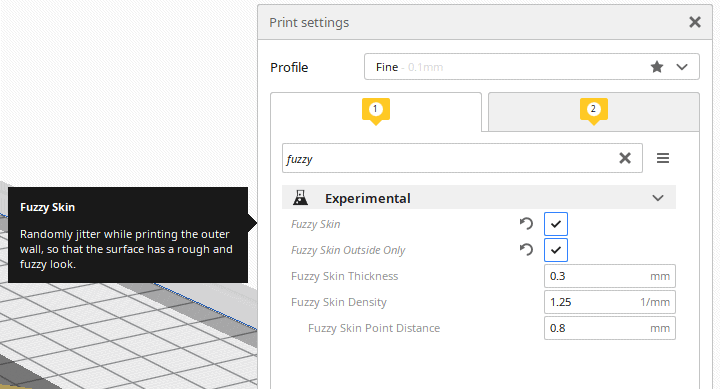- Is a Wash & Cure Station Worth It? Creality UW-03 Review - April 29, 2024
- Z Seam | How to Hide & Avoid | Cura & PrusaSlicer - April 20, 2024
- Qidi Tech Q1 Pro – Best Orca Slicer Settings & Profile - April 9, 2024
Disclosure: Links marked with * are Affiliate Links. I earn from qualifying purchases if you decide to make a purchase through these links – at no additional cost for you!
The subject of 3D printing is both electrifying and captivating. Surely you will find the term and everything that goes with it exciting and modern.
In fact, this trend is becoming more and more popular and is also gaining more and more recognition. Meanwhile, there are many different settings and designs that make it even more exciting. If you want to learn all you need to know about the innovative Cura Fuzzy Skin setting, then you’ve come to the right place!

Table of Contents:
3D Printing is Gaining in Fascination
At first, this captivating and creative trend was considered a short-lived hype. But by now, everyone seems to know that it is a real industry! And apparently there is no end in sight, as the market for this unique product is growing steadily.
As you have probably noticed, even big players are now offering their products on this particular market. At the latest then it is clear that this is a profitable trend. These giants in the technology market include Siemens and HP, among others.
What may surprise you is the fact that this innovative technology has its origins in the early 1980s. Since then there have been more and more developments and improvements in this process. Further variants and methods follow a continuous development.
Before you are introduced in detail to the Cura Fuzzy Skin setting, you will first learn everything you need to know about 3D printing. You’ll also get a glimpse into the now diverse range of settings for this creative trend.
What does 3D Printing Mean?
Are you also interested in what actually makes 3D printing so extraordinary? This custom print form has some impressive aspects that might surprise you.
What makes 3D printing so unique is the special structure of the product. The workpieces are built up layer by layer and printed together in a continuous process to form a whole.
Therefore, this technique is also called additive manufacturing or generative manufacturing. Interestingly, this form of manufacturing is the exact opposite of milling. This is because a specific object is peeled out of a block of material.
As the name suggests, this manufacturing process creates a three-dimensional object. The print job is computer-controlled, whereby a given shape is created from one or more liquid or solid materials.
Normally, recyclable materials such as metals, ceramics, plastics or even synthetic resins are used for printing. In the meantime, some niche products are also used or tested. It is surprising that the use of casting molds is not necessary for the creation of concrete products. In fact, one completely dispenses with these special tools.
What are the Different Printing Processes?
The diverse suppliers of 3D printers certainly differ in some aspects. This large number of products may have confused you. Ultimately, 3D printers fall into three different classifications.
Industrial 3D Printers
This segment includes the printers that have the strongest performance and are classified as particularly high-quality. As you might have guessed, these models achieve pure excellence in the areas of reliability and accuracy. Of course, 3D printers in this size range are also highly-priced.
Semi-Professional Applications
In this weakened segment you will find primarily FDM and SLA/DLP printers. These belong to the low-cost variants and offer a weakened service of industrial products.
Therefore you get good quality with these products. However, this quality is usually completely sufficient for the intended use.
Hobby Applications
Also in this model segment you will find the printer variants SLA/DLP and FDM. Especially the extremely low-priced variants can be found in this segment.
These 3D printers, sold primarily for home use, are of acceptable quality in this respect. However, their reliability cannot compete with industrial models.
What Settings can 3D Printers Have?
The possible settings and functions naturally depend on the printer model selected. In addition, the different modeling software also have different settings.
The well-known 3D modeling software includes the programs Tinkercad, Onshape and Cura. In the following you will learn more about the software Cura, which offers many fascinating settings.
When using the software, you can distinguish very well which basic settings are perfectly sufficient for a simple printing process. In addition, it is advisable to get used to certain abbreviations for long-term use. These save a lot of time in the editing process.
If you already know the basic settings, then it’s worth taking a closer look at the advanced settings. There you’ll find many different tools to perfect your 3D printing.
The “Experimental” tab lists the “Fuzzy Skin” setting, which will be discussed in more detail below.
The Setting “Fuzzy Skin” of the Software Cura
The new version of the Cura printing software presents new exciting features. The Dutch 3D printer specialist Ultimaker is distributing this new version and promises you additional exciting features.
The cool “Fuzzy Skin” feature is part of these reworked as well as elaborated features and promises you a whole new dimension in modeling your 3D prints. As the name already tells you, this setting creates a certain surface structure.

The setting processes the surface to make it look similar to microfibre. This means that the printer travels the outer lines in a jerky way. This makes the structure of the surface rough.
In addition, this means that the so-called Fuzzy Skin is only applied on the outside. This prevents this surface structure from appearing inside objects. As a result, the parts can be placed more easily into each other. This setting works on all levels, i.e. horizontally as well as diagonally.
For Which Objects is “Fuzzy Skin” Suitable?
So what can you use this new feature for? Due to the fact that it roughens the surface structure of an object, the regular visible lines become invisible. So this particular tool is great for parts that you want to give a unique surface appearance.
This includes figures whose skin surface or fur you want to highlight. With Fuzzy Skin the cover gets a look that makes the whole piece look much more plastic.
Accordingly, you can use this setting whenever you want to emphasize the structure of your workpiece. Specifically the representation of fur in animal depictions makes Fuzzy Skin work well.
For the new extended function, which means that Fuzzy Skin only appears on the outside of the print object, there are other uses you can try out.
As this extension means that the surface is only roughened on the outside, this technique is particularly suitable for printing handles or similar objects. This is due to the fact that the parts can be very well placed on other objects.
Basically, there are no limits to your imagination. Surely you have many ideas of your own what you want to create with this special attitude. The advantage of 3D printing is that you can easily turn your ideas into a physical object.
Where can I find the “Fuzzy Skin” Setting?
In your Cura Modeling software you will find a large number of different and unique settings. Therefore it can happen that you may not find the Fuzzy Skin setting at first sight. Don’t worry, here you will find out exactly where to look.
At the very bottom of the settings bar in the opened software you will find the tab “Experimental”. Below it, you will find several modeling tools that you can use with one mouse click. Among these tools, you will quickly find the setting “Fuzzy Skin”.
If you cannot find it immediately, you can also use the search function:

As soon as you click on the box next to it, your print will be created for you in this style. This setting also allows you to configure the characteristic values yourself. This means that you can set the thickness and density of the fuzzy skin. Another additional setting of the tool is the distance to the main point.
All in all, the setting is very easy for you. You have many possibilities to customize the tool to your individual needs. In the end, you decide what you want to create.
Conclusion – 3D Printing and the Fuzzy Skin Feature
With 3D printing, you can immerse yourself in a dynamic and innovative world that offers many surprising and fascinating tools. Predicting the future is indeed very difficult in terms of market changes and new developments in this field.
However, it can be said with certainty that this technology will continue to expand both in industrial production and private use. Ultimately, 3D printing offers a wide range of uses to support research and development.
It is highly probable that many of the possibilities offered by this technology have not yet been developed. It takes creative and analytical minds like you to generate the far-reaching potential and opportunities for the future.
The “Fuzzy Skin” setting certainly makes a decisive contribution to these forecasts.
This tool makes it possible to adapt and refine the surface structure. Many production sites and private households can benefit from this function. On the one hand for the outstanding suitability for the production of handles. But also for the novel design possibilities.
The application of the software Cura is basically easy to understand and therefore also suitable for a beginner. In this modeling software, you are free to act out and create things you have always dreamed of. No matter if you need a 3D printer for your private pleasure or for business.
You will definitely benefit from this technique and discover the beautiful variations and designs for yourself. With “Fuzzy Skin” you will experience a special and yet almost inconspicuous design suggestion, which will give your valuable piece that certain special nuance. A beautiful feature that not only industrial production will discover for itself.
Disclosure: This website is the property of Martin Lütkemeyer and is operated by Martin Lütkemeyer. Martin Lütkemeyer is a member of the Amazon Services LLC and other Affiliate Programs. These are affiliate advertising programs designed to enable websites to earn advertising revenue through advertising and linking to Amazon.com and others. Links marked with * are affiliate links.

